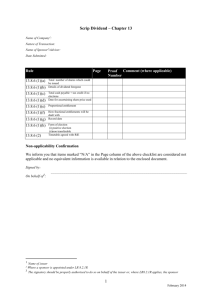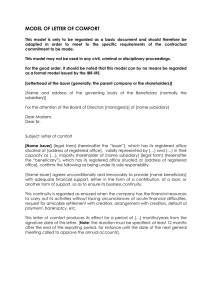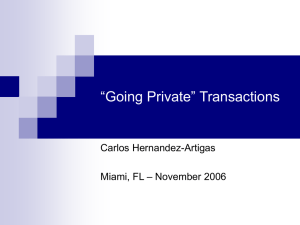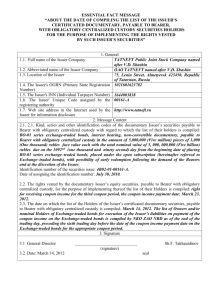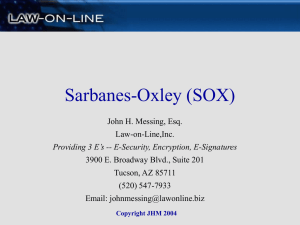Financial Reporting Decisions 8 December 2015
advertisement
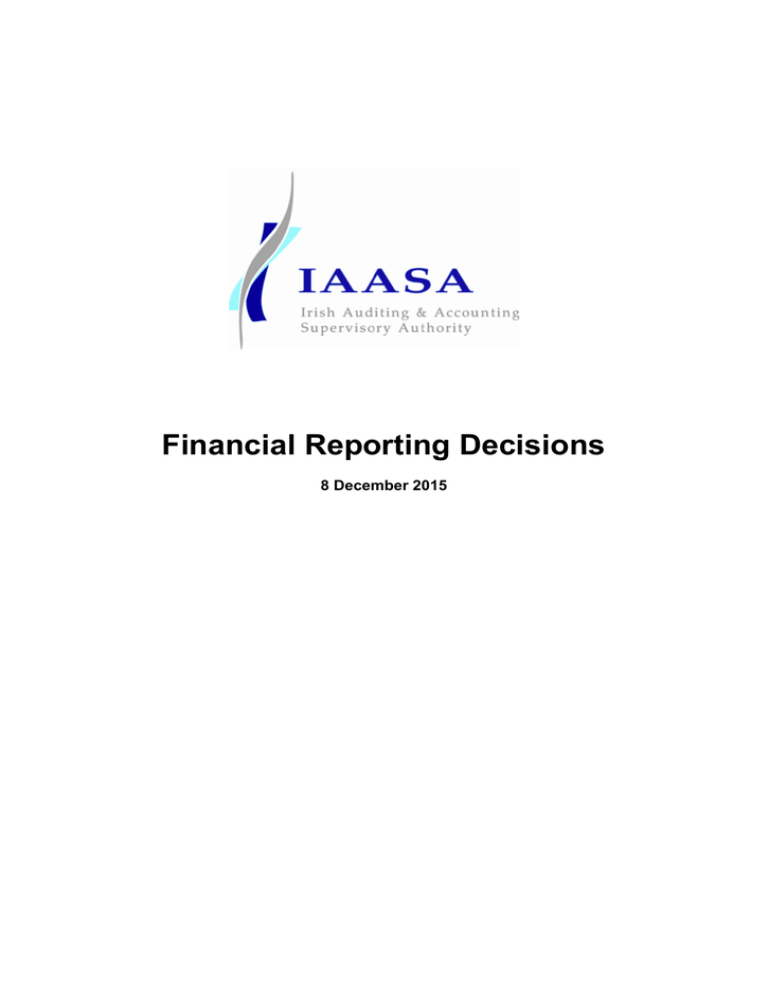
Financial Reporting Decisions 8 December 2015 Contents Page 1. 2015/002 – Irish Residential Properties REIT plc .................................................................. 1 – 5 2. 2015/003 – IFG Group plc ...................................................................................................... 6 – 7 3. 2015/004 – UDG Healthcare plc ............................................................................................ 8 – 9 4. 2015/005 – Paddy Power plc .............................................................................................. 10 – 12 5. 2015/006 – Dragon Oil plc....................................................................................................13 – 14 Issuer Irish Residential Properties REIT plc Report type Annual financial statements Reporting period Period ended 31 December 2014 Financial reporting framework IFRS-EU Applicable financial reporting standards IFRS 7 Financial Instruments: Disclosures IFRS 13 Fair Value Measurement IAS 1 Presentation of Financial Statements IAS 7 Statement of Cash Flows IAS 24 Related Party Disclosures Transparency (Directive 2004/109/EC) Regulations 2007 (‘S.I. 277 of 2007’) Corporate Governance Code Irish Annex to the Corporate Governance Code Summary Irish Residential Properties REIT plc (‘the issuer’) provided IAASA with a number of undertakings to enhance disclosures in future periodic financial statements with regard to, amongst other matters: a) property valuation disclosures; b) key management personnel compensation; c) interest rate risk sensitivity; d) the statement of cash flows; and e) various disclosures relating to the Corporate Governance Code and the Transparency (Directive 2004/109/EC) Regulations 2007 (S.I. 277 of 2007). Background The issuer is a Real Estate Investment Trust and owns approximately 1,500 multi-unit residential rental apartment properties in or near urban centres in Dublin. IAASA performed an unlimited scope examination of the issuer’s annual financial statements for the period from 2 July 2013 (date of incorporation) to 31 December 2014, that being the issuers first annual financial statements. Outline of financial reporting treatment applied by the issuer and outline of decisions made by IAASA 1. Property valuation – IFRS 13 Treatment Finding In its 2014 annual financial statements, the issuer disclosed that the “capitalisation rate” and “stabilised net rental income” were the key unobservable inputs. Stabilised net rental income represents the net rental income from a stabilised portfolio, defined as all properties owned continuously during an accounting period. With regard to the capitalisation rate, the issuer disclosed the information required by IFRS 13.93. Decision 2015/002 However, with regard to, the stabilised net rental income, the issuer’s fair value notes did not disclose: a) a description of the valuation technique and the 1 inputs used in the fair value measurement of the investment property [IFRS13.93(d)]; b) quantitative information about the significant unobservable inputs used in the fair value measurement of investment property [IFRS13.93(d)]; and c) the narrative description of the sensitivity of the fair value measurement to changes in unobservable inputs if a change in those inputs to a different amount might result in a significantly higher or lower fair value measurement [IFRS 13.93(h)(i)] As part of their engagement with IAASA, the directors referred to the fact that the Decisions related to the first annual financial statements of the issuer and committed that all the matters raised would be dealt with for subsequent reporting periods. Accordingly, they undertook to include the stabilised net rental income as a significant unobservable input and to disclose the information required by IFRS 13.93 (d) and IFRS 13.93(h)(i) in future periodic financial statements. 2. Key Management Personnel compensation Treatment Finding The financial statements disclosed an amount for directors’ remuneration under the following categories: The key management personnel compensation note did not disclose the information required by Paragraph 17 of IAS 24 Related Party Disclosures. IAS 24.17 requires an entity to disclose key management personnel compensation in total and for each of the following categories: a) fees for services as Directors; and a) short-term employee benefits; b) post-employment benefits; c) other long-term benefits; d) termination benefits; and e) share-based payment. b) fees for other services. The directors provided an undertaking that future financial statements will disclose the information required by IAS 24.17. 3 Interest rate risk Treatment Finding The financial statements disclosed that: The interest rate risk disclosure note did not disclose the methods and assumptions used in the calculation of the interest rate risk sensitivity, as required by paragraph 40(b) of IFRS 7 Financial Instruments: Disclosures. “An increase or decrease in interest rate by 100 basis points will result in an increase/decrease of interest payable of €1.3 million and Decision 2015/002 The directors provided an undertaking that future financial statements will disclose the methods and 2 €20,000, respectively, on debt of €125 million, on an annualised basis” 4 assumptions used in the calculation of the interest rate risk sensitivity. Operating income items related to financing and investing activities – Statement of Cash Flows Treatment Finding Included in the Statement of Cash Flows was an amount of €2,415,000 for “operating income items related to financing and investing activities”. The composition of the item “operating income items related to financing and investing activities” was not disclosed in the financial statements. Paragraph 10 of IAS 7 Statement of Cash Flows states that the Statement of Cash Flows shall “report cash flows during the period classified by operating, investing and financing activities.” The directors provided an undertaking that future financial statements will provide the composition of the item “operating income items related to financing and investing activities”. 5 Audit Committee Report – significant issues Treatment Finding The Report of the Audit Committee was disclosed on pages 33 and 34 of the issuer’s 2014 Annual Report. The Report of the Audit Committee did not disclose the significant issues that the Audit Committee considered in relation to the financial statements Section C.3.8 of the Corporate Governance Code 2012 requires an issuer to describe in its annual report the significant issues that the Audit Committee considered in relation to the financial statements and a description as to how these issues were addressed. The directors provided an undertaking that the Report of the Audit Committee will be expanded in future annual reports to include the significant issues that the Audit Committee considered in relation to the financial statements. 6 Audit Committee Report – oversight of Risk Management Treatment Finding The Report of the Audit Committee was disclosed on pages 33 and 34 of the issuer’s 2014 Annual Report. The Report of the Audit Committee did not provide a description of the work done by the Audit Committee relating to the oversight of risk management. Sections 5.1 and 5.2 of the Irish Annex to the Corporate Governance Code requires an issuer to explain in its annual report the work done by the Audit Committee relating to the oversight of risk management on behalf of the Board. The directors provided an undertaking that the Report of the Audit Committee will be expanded in future annual reports to include the work of the Audit Committee with regard to its oversight of risk management. Decision 2015/002 3 7 Valuation basis – terminology Treatment Finding The financial statements disclosed the following terms: The terms were not defined in the financial statements. a) capitalisation rates; b) equivalent yield; c) stabilised net rental income (‘NRI’); and d) estimated annual rent. Paragraph 112(c) of IAS 1 Presentation of Financial statements states that the notes to the financial statements will “provide information that is not presented elsewhere in the financial statements, but is relevant to an understanding of any of them.” The directors provided two undertakings: a) to ensure consistency with the terminology used by external valuators the term “equivalent yield” will be used for the commercial component of the investment property in future financial statements; and b) to aid users understanding of the financial statements the following terms will be defined in future financial statements: 8 - net initial yield; - capitalisation rate - equivalent yield; - stabilised net rental income; and - estimated annual rent. Responsibility Statement Treatment Finding The Responsibility Statement is included in the Statement of Directors’ Responsibilities. The Responsibility Statement did not refer the description of the principal risks and uncertainties that the issuer faces. The requirements for the responsibility statement are set out in Regulation 5(4)(c)(ii) of the Transparency (Directive 2004/109/EC) Regulations 2007 (S.I. 277 of 2007). The directors provided an undertaking that the wording of the responsibility statement will be amended to comply in full with the requirements of Regulation 5(4)(c)(ii) of S.I. 277 of 2007 for future financial statements. 9 Proposed dividends Treatment Finding The financial statements disclosed that: The total amount of proposed dividend was not disclosed and such disclosure is required by paragraph Decision 2015/002 4 137(a) of IAS 1 Presentation of Financial Statements “… the Directors have resolved to pay a maiden dividend of 0.48 cent per share in the form of an interim dividend to be paid on 31 March 2015 to shareholders on record as at 20 February 2015.” The directors provided an undertaking that future financial statements will disclose the information required by IAS 1.137(a). IAASA will conduct a follow-up examination of the issuer’s annual financial statements for the year ended 31 December 2015 to evaluate the extent to which the undertakings have been met by the directors. Return to Contents Decision 2015/002 5 Issuer IFG Group plc Report type Annual financial statements Reporting period Year ended 31 December 2014 Financial reporting framework IFRS-EU Applicable financial reporting standards IFRS 8 Operating Segments Summary This financial reporting decision concerns the information reviewed by the Chief Operating Decision Maker (‘CODM’). In particular, IAASA considered that the absence of disclosure of certain segmental information in the financial statements did not fully comply with IFRS 8 Operating Segments. IFG Group plc (‘the issuer’) provided IAASA with undertakings to enhance its operating segment disclosures in future periodic financial statements. Background The issuer is a financial services company providing pension administration and independent financial advice. Under IFRS 8 an entity is required to disclose information about its operating segments, its products and services, the geographical areas in which it operates, and its major customers. IAASA performed a focussed examination of the issuer’s annual financial statements for the year ended 31 December 2014. Outline of financial reporting treatment applied by the issuer In its 2014 annual financial statements, the issuer disclosed that it had two operating segments. The issuer also identified the CODM as being the Group Chief Executive Officer (‘CEO’). The issuer’s IFRS 8 note did not disclose: a) a measure of the total assets and liabilities for each reportable segment [IFRS 8.23]; b) reconciliations of the total reportable segments’ assets and liabilities to the entity’s assets and liabilities [IFRS 8.28(c) and (d)]; c) the amounts of additions to non-current assets other than financial instruments, deferred tax assets, net defined benefit assets and rights arising under insurance contracts [IFRS 8.24(b)]; and d) a description of the “types of products and services from which each reportable segment derives its revenues”. [IFRS 8.22(b)]. The information required by IFRS 8.22(b) could be obtained from the Strategic Report. However, the Strategic Report did not form part of the IFRS set of financial statements. With regard to items a) to c) above, the issuer informed IAASA that its rationale for not providing the disclosures was that: a) a measure of the total assets and liabilities for each reportable segment is not regularly provided to the CODM and accordingly the disclosures required by IFRS 8.23 and the reconciliations required by IFRS 8.28 (c) and (d) are not relevant; and b) non-current asset additions are not regularly provided to the CODM. The issuer explained that the CODM reviews working capital and overall balance sheet performance on a Group wide basis and accordingly the disclosure required by IFRS 8.24 is not relevant. Decision 2015/003 6 In explaining how the CODM makes decisions regarding the allocation of resources when the total assets and liabilities for each reportable segment together with the non-current asset additions are not provided to the CODM, the issuer explained that: a) each segment has its own legal entity structure; b) the CODM is on the Board of each reportable segment and receives extensive financial information at that level; c) the CODM has full visibility of the assets and liabilities of each segment through his membership of the subsidiary Boards; and d) at group level, the day-to-day running and management of the businesses are delegated to executives. Outline of decisions made by IAASA IAASA reviewed the segmental monthly reporting information pack provided to the CEO (CODM) which at group level does not include segmental assets and liabilities. The issuer’s interpretation of the IFRS 8 requirements is that disclosure is only based on the information received by the CODM at group level rather than segmental level. However IFRS 8.23 states: “An entity shall report a measure of total assets and liabilities for each reportable segment if such amounts are regularly provided to the chief operating decision maker….” IFRS 8.24(b) states: “An entity shall disclose the following about each reportable segment if the specified amounts are included in the measure of segment assets reviewed by the chief operating decision maker or are otherwise regularly provided to the chief operating decision maker even if not included in the measure of segment assets: ….. (b) the amounts of additions to non-current assets other than financial instruments, deferred tax assets, net defined benefit assets and rights arising under insurance contracts…..” The issuer confirmed to IAASA that the CODM did receive information regarding the assets and liabilities of each reportable segment in his capacity as a Board member of the subsidiary companies and IAASA examined this material. The issuer, therefore, accepted IAASA’s view that the assets and liabilities, together with the non-current asset additions of each reportable segment is being provided to the CODM and, accordingly, the information should be disclosed in accordance with IFRS 8. Outline of corrective actions undertaken or to be undertaken Following engagement with IAASA, the directors undertook to provide in their next annual financial statements to: a) disclose a measure of the total assets and liabilities for each reportable segment [IFRS 8.23]; b) disclose the non-current asset additions for each reportable segment [IFRS 8.24(b)]; and c) include a cross reference from the segmental disclosures note to the strategic report for the description of the types of products and services from which each reportable segment derives its revenues [IFRS 8.22(b)]. Return to Contents Decision 2015/003 7 Issuer UDG Healthcare plc Report type Annual financial statements Reporting period Year ended 30 September 2014 Financial reporting framework IFRS-EU Applicable financial reporting standards IAS 36 Impairment of Assets Summary This financial reporting decision concerns the discount rate applied by UDG Healthcare plc (‘the issuer’) in respect of determining the recoverable amount for its cash generating units (‘CGUs’) and related disclosures. Background The issuer is an international provider of services to the healthcare industry and is in the process of transforming its business from that of pharmaceutical wholesaling to one of global pharmaceutical services. The issuer has eleven CGUs across three operating segments. In the financial statements the issuer has identified three CGUs to which significant amounts of goodwill have been allocated. Paragraphs 55 to 57 of IAS 36 require the discount rate used in the value in use calculation to reflect, amongst other matters, the risks specific to the asset. The discount rate should reflect the current market return that investors would require from an investment with similar cash flows (amount and timing) and risk profile of the investment. IAASA performed a focused examination of the issuer’s annual financial statements for the year ended 30 September 2014. Outline of financial reporting treatment applied by the issuer It was noted from the financial statements that the average discount rate used in the value in use calculations was 10% and was unchanged since 2009. The strategic direction of the issuer and its financial position has changed considerably over that time. The issuer has re-focused its business away from pharmaceutical wholesaling and towards becoming a provider of services to the healthcare industry. It has grown total assets by more than 50% and revenue by more than 25% during that time. The issuer confirmed that it used the Capital Asset Pricing Model to determine the weighted average cost of capital (‘WACC’) which was the basis for its discount rate. The issuer also confirmed that it had used a single group-wide WACC as the basis for discounting the cash flows for all the significant CGUs rather than a CGU specific rate for each CGU. The issuer’s rationale for the single group-wide discount rate being unchanged since 2009 was because it believed the discount rate gave a level of prudence to the impairment review process. IAASA noted that, notwithstanding the discount rate used, there was a substantial amount of headroom available based on the issuer’s calculation. Outline of decisions made by IAASA Paragraphs 55 to 57 of IAS 36 require the use of an asset specific rate (as distinct from an average group-wide rate). Paragraph A19 of IAS 36 requires the use of a market based discount rate that is independent of the entity’s capital structure. Paragraph A18 of IAS 36 requires that discount rates be adjusted “to reflect the way that the market would assess the specific risks associated with the asset’s [bold emphasis added] estimated cash Decision 2015/004 8 flows” and “exclude risks that are not relevant to the assets estimated cash flows or from which the estimated cash flows have been adjusted.” In addition, paragraph 134(d)(v) of IAS 36 requires disclosure of the discount rate for each CGU for which the goodwill or intangible asset with indefinite life is significant. IAASA concluded that: a) the use of a discount rate based on a single group-wide WACC to discount all CGUs’ cash flows does not comply in full with paragraphs 55 to 57 of IAS 36 and related guidance in Appendix A of same; and b) the issuer had not disclosed the discount rate for each CGU having a significant amount of goodwill or intangibles as required by paragraph 134(d)(v) of IAS 36. Outline of corrective actions undertaken or to be undertaken The issuer provided undertakings to IAASA to: a) discontinue its practice of using a single group-wide WACC to determine the recoverable amount of its CGUs; and b) disclose the discount rates by individual CGU with significant goodwill in future financial statements. Return to Contents Decision 2015/004 9 Issuer Paddy Power plc Report type Annual financial statements Reporting period Year ended 31 December 2014 Financial reporting framework IFRS-EU Applicable financial reporting standards IFRS 3 Business Combinations Summary This financial reporting decision concerns the recognition separately from goodwill, of the identifiable intangible assets acquired through a business combination [IFRS 3.10]. Paddy Power plc (‘the issuer’) provided explanations as to why the intangible assets (i.e. brands and customer relationships) acquired in a business combination were not recognised separately from goodwill. Following the receipt of the issuer’s explanations, IAASA did not require the issuer to make corrective actions and concurred with the issuer not to recognise the brands and the non-contractual customer relationships as intangible assets for its 2014 business combinations. Background The issuer is an international betting and gaming group. IFRS 3 Business Combinations is applicable when an acquirer obtains control of a business as a result of an acquisition. Any goodwill arising on acquisition is recognised as an asset and is tested for impairment on an annual basis. IFRS 3 also requires an acquirer at the acquisition date, to recognise separately from goodwill, the identifiable intangible assets acquired, the liabilities assumed and any non-controlling interest in the acquiree. A large percentage of the assets of equity issuers’ under IAASA’s remit is made up of goodwill and intangible assets acquired. Therefore, equity issuers’ recognition (or non-recognition) of goodwill and intangible assets following a business combination was an area of focus for IAASA during 2015 examinations and included in IAASA’s 2015 Observations Document. IAASA performed a focussed examination of the issuer’s annual financial statements for the year ended 31 December 2014. Outline of financial reporting treatment applied by the issuer In its 2014 annual financial statements, the issuer disclosed that it acquired betting shops for €8.3m The issuer informed IAASA that it acquired 23 betting shops in 2014. The identifiable net assets acquired and recognised comprised of Property, Plant and Equipment of €0.6m and goodwill of €7.7m. The goodwill accounted for 93% of the total consideration price. IFRS 3.10 and IFRS 3.B31 requires an acquirer to recognise, separately from goodwill, the identifiable intangible assets acquired through a business combination. IFRS 3 indicates that an intangible asset is identifiable if it meets the separability criterion or the contractual-legal criterion. The issuer informed IAASA that no identifiable intangible assets were acquired for the following reasons: a) the betting shops once acquired no longer trade under their existing brand and immediately assume the issuer’s brand; and b) there are no contractual arrangements with customers to ascribe a value to, and even though there may be non-contractual customer relationships, there is no guarantee that these relationships will continue into the future or that they could be accurately and separately valued. Decision 2015/005 10 (1) Brands Paragraphs 30 of IFRS 13 Fair Value Measurement and B43 of IFRS 3 Business Combinations both indicate that to protect its competitive position, an entity may intend not to use an acquired nonfinancial asset actively, or it may intend not to use the asset according to its highest and best use. In such circumstances, the entity must measure the fair value of a non-financial asset assuming its highest and best use by market participants. In providing its detailed explanation as to why the brands acquired on acquisition had not been valued in line with IFRS 13.30 and IFRS 3.B43, the issuer explained that the: a) betting shops acquired in 2014 were shops of smaller competitors. Relative to the issuer the betting shops do not have a significant brand presence in the wider retail gambling market and would not be as well known outside of the specific locations where they operate; b) the “brand” of the acquired shop is oftentimes the name of the vendor or the location of the shop. The issuer indicated that it did not acquire the right to the brand name and placed no restriction on the continued use of the brand by the vendor post the acquisition. In fact the value of the brand is not part of the net assets acquired in return for the consideration paid by the issuer to the vendor; c) the economic rationale for paying €8.3m for €0.6m of Property Plant and Equipment was to try to acquire betting shops in locations where there is a demand for gambling services. The issuer also explained that the premium paid for the acquired businesses represents the issuer’s ability to increase its retail branch network and to utilise the issuer’s brand and industry knowledge to improve the financial performance of the acquired businesses in order to add to the overall value of the issuer. (2) Non-contractual customer relationships It appeared to IAASA that the issuer may have had non-contractual customer relationships. Paragraph IFRS 3.IE28 appeared to be of relevance: Paragraph IE 28 of IFRS 3 states that: “A customer relationship exists between an entity and its customer if (a) the entity has information about the customer and has regular contact with the customer and (b) the customer has the ability to make direct contact with the entity. Customer relationships meet the contractual-legal criterion if an entity has a practice of establishing contracts with its customers, regardless of whether a contract exists at the acquisition date. Customer relationships may also arise through means other than contracts, such as through regular contact by sales or service representatives” [bold emphasis added]. Given that the issuer acquired a number of businesses which were already operated as retail betting shops, it could be argued that: a) customer relationships were in existence on the acquisition date through regular contact and indeed face to face contact with the original operator’s staff by accepting the bets in store; and b) the issuer may have acquired these betting shops in locations where there were no other betting shops. In such cases, customers would continue to attend the same betting shop, irrespective of whether the issuer acquired it or not. Such non-contractual customer relationships may have a value if these customers continue to place their bets in the same shop. It is possible that these customer relationships could be separately identifiable and therefore have a value. In explaining why it did not recognise any non-contractual customer relationships for its 2014 business combinations, the issuer informed IAASA that: a) each of the issuer’s shops has a customer base which is separate and different to customer lists. Customer bases do not meet the separability criterion or the contractual-legal criterion Decision 2015/005 11 for recognition as an intangible asset; b) the locations where the issuer operates would be competing against other betting shops. As a result, customers would have a choice of betting shops and may not necessarily place a bet with the issuer’s shop; and c) it does not obtain any contact information for its betting shop customers. Outline of Decisions made by IAASA (1) Brands Given that the issuer confirmed that it did not acquire the right to the brand and did not place any restrictions on its continued use by the vendor, together with the other reasons outlined above, IAASA concurred with the issuer in not recognising the brands as an intangible asset for its 2014 business combinations. (2) Non-contractual Customer Relationships IAASA considered a customer base to represent a group of customers that are not known to an entity. Non-contractual customer relationships that are identified as customer bases are not separately recognised as an intangible asset because they do not arise from contractual or legal rights and are not separable. IAASA concluded that it is appropriate that such customer bases to be included as part of goodwill. For the reasons outlined above, IAASA concurred with the issuer not to recognise non-contractual customer relationships as intangible assets for its 2014 business combinations. Outline of corrective actions undertaken or to be undertaken None required as IAASA concurred with the issuer’s financial reporting treatment. Return to Contents Decision 2015/005 12 Issuer Dragon Oil plc Report type Annual financial statements Reporting period Year ended 31 December 2014 Financial reporting framework IFRS-EU Applicable financial reporting standards IAS 12 Income Taxes Summary This financial reporting enforcement decision concerns the treatment adopted by Dragon Oil plc (‘the issuer’) in respect of the write-back of corporate tax over-provisions recognised in earlier years and reversed in the current year. IAASA concurred with the issuer’s financial reporting treatment. Background The issuer is an independent international oil and gas exploration, development and production company. Its principal producing asset is in the eastern section of the Caspian Sea, offshore Turkmenistan. It has exploration blocks in partnership with other entities. IAASA performed a focused examination of the annual financial statements of the issuer for the year ended 31 December 2014. Outline of financial reporting treatment applied by the issuer The issuer, through its wholly owned subsidiary, operates a Production Sharing Agreement (‘PSA’) between it and the Turkmenistan authorities for a term of 25 years which expires in May 2025 with an exclusive right to negotiate an extension for a further period of not less than 10 years. In its 2014 annual financial statements, the issuer recognised an income tax credit amounting to US$160m relating to over-provisions in respect of prior years up to 2013. The notes to the 2014 annual financial statements disclosed that: a) in 2014, the issuer and the Turkmenistan authorities agreed to amend the provisions of the PSA to bring the tax rate into line with the provisions of the Tax Code of Turkmenistan; b) a tax rate of 20% is now applicable to the issuer in respect of its petroleum operations in Turkmenistan; c) the issuer has applied this rate in determining its tax liabilities as at 31 December 2014; and d) the impact of the reduction in the tax rate is a reversal of US$160m in respect of an overprovision for prior years up to 2013, no longer payable. The notes to the issuer’s annual financial statements for the year ended 31 December 2013 had disclosed that: “During 2008, the effective tax rate applicable to the Group’s operations in Turkmenistan was increased by 5% to 25% by the Hydrocarbon Resources Law of 2008.The Group has continued to apply this [25%] rate in determining its tax liabilities as at 31 December 2013. The Group is in discussions with the authorities in Turkmenistan about the applicability of this rate to periods prior to 2008, but it does not believe that these prior periods are affected by this increase. A provision of US$11.1 million has been made in respect of the additional tax that could become payable if the increased tax rate were applied to prior periods.” Decision 2015/006 13 The enforcer queried the issuer seeking a reconciliation as to how the 2014 credit amounting to US$160m reconciled to the US$11m disclosed in the issuer’s 2013 annual financial statements and seeking a detailed explanation as to how the 2014 credit amounting to US$160m had been measured. The issuer explained that for the years prior to 2008, the tax rate in force in Turkmenistan was 20% and that the issuer recognised and paid its tax obligations based on that 20% rate. Consequently, no tax under/over-provision arose in that period. The issuer explained that the Hydrocarbon Resources Law in Turkmenistan in 2008 increased the rate from 20% to 25% but there was divergence in views between the issuer and the Turkmenistan authorities as to the date from which this higher rate was effective – the Turkmenistan authorities asserted that it applied from 2004 and the issuer believed that it applied from 2008. The issuer measured its tax obligations based on the higher 25% rate from 2008 onwards but continued to pay its taxes based on the 20% rate. The issuer provided for its best estimate of the amount it expected to pay in respect of the period prior to 2008 and continued to contend that the higher 25% rate applied only to years from 2008; accordingly, accrued taxes amounting to US$11m were recognised. The issuer explained that in 2014, it agreed with the Turkmenistan authorities to amend the provisions of the PSA to bring the tax rate into line with the provisions of the Tax Code of Turkmenistan and that a 20% tax rate applied for all years, and not just for the period from 2008 to date. The issuer thus recognised and paid its tax obligations based on that lower 20% rate. As this 20% rate applied in 2014 and retrospectively to all previous years by virtue of the PSA being renegotiated, this resulted in an over provision for taxation amounting to US$149m for the years 2008 to 2013 as the issuer had provided at a 25% rate for those years; the additional US$11m for the years prior to 2008 was also recognised as on over-provision. Outline of decision made by IAASA IAASA concurred with the issuer’s financial reporting treatment and disclosures. Paragraph 46 of IAS 12 requires that current tax liabilities be measured at the amount expected to be paid to the tax authorities using the tax rates that have been (substantively) enacted by the end of the reporting period. The issuer and the Turkmenistan authorities had agreed by 31 December 2014 that the tax rate applicable on its petroleum operations was 20% for all periods up to and including 2014. Outline of corrective actions undertaken or to be undertaken None required as IAASA concurred with the issuer’s financial reporting treatment and disclosure. Return to Contents Decision 2015/006 14
